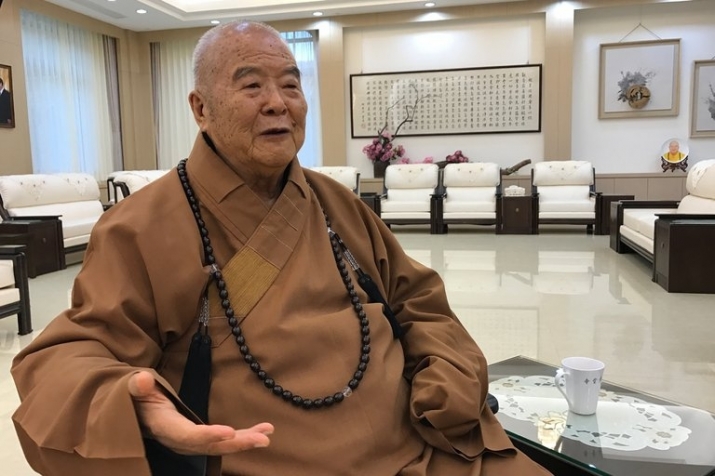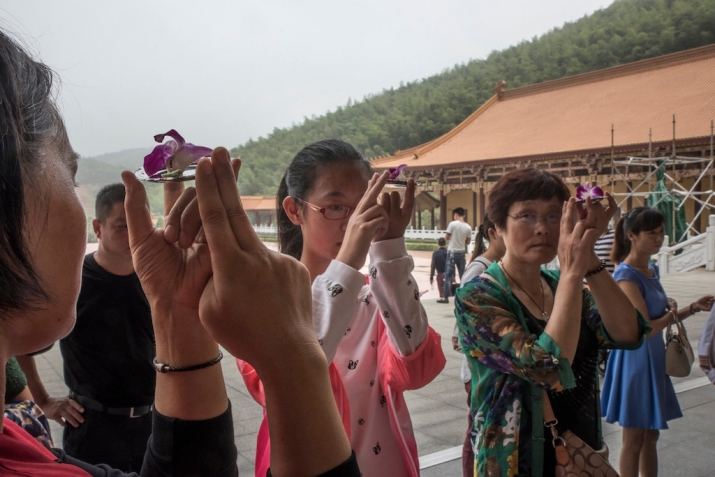NEWS
Master Hsing Yun Articulates Vision for China’s Buddhist Future
 Master Hsing Yun in October 2016. From The New York Times
Master Hsing Yun in October 2016. From The New York TimesMaster Hsing Yun, the founder and leader of the Taiwan-based Buddhist organization Fo Guang Shan, shared a unique insight into his Dharma work in the People’s Republic of China with journalists Ian Johnson and Adam Wu of The New York Times. In the interview, he stated: “The new generation of Buddhists lacks talent, education, and role models. I encourage fellow Buddhists to strive for kindness.” (New York Times)
The 90-year-old monastic spoke with The New York Times for over an hour at the Temple of Great Awakening, which was completed in 2012, in the city of Yixing. The construction of the temple, built with funds from Fo Guang Shan, is the most recent example of the Chinese government’s trust in the organization, allowing them to conduct religious activities in China. Fo Guang Shan maintains that it and the Chinese government share the similar goal of promoting traditional Chinese spirituality (including Daoism and Confucianism, but especially Buddhism).
Master Hsing Yun noted that Chinese president Xi Jinping’s campaign to rejuvenate traditional Chinese values matches the Buddhist critique of Chinese society after the Cultural Revolution and Deng Xiaoping’s economic reforms. Master Hsing Yun feels that China has become too materialistic, while capitalism has grown too cutthroat. The ancient values of Chinese humanity should be strengthened to build bonds between people. “I think, in the secular world, they want money and love. But they also need peace, safety, and happiness. In this regard I offer them encouragement, truth, and transcendence. By influencing them, I make them relieved both physically and mentally, unrestrained and stable,” said Master Hsing Yun. (New York Times)
The government’s support for Fo Guang Shan has steadily grown since the early 2000s. Fo Guang Shan now has cultural centers in four cities, among them Beijing and Shanghai. The New York Times reports that among Master Hsing Yun’s students there are government officials, who frequent the cultural centers to recite sutras, listen to lectures about Buddhist philosophy, and retreat at the centres to live like monastics for a short time. Even president Xi has met Master Hsing Yun for four times since 2012. In one meeting, the Chinese leader told the Humanistic Buddhist thinker, “I’ve read all the books that master sent me.” (The New York Times)
Master Hsing Yun, in turn, offered the following views on his relationship with the Chinese government: “I support the leadership. They care for us as well. It is mutual. We Buddhists uphold whomever is in charge. Buddhists don’t get involved in politics. But we respect the leadership, ethics, and rule of law.” He noted that he agrees with president Xi’s view that the mainland and Taiwan belong to the “same family.” (The New York Times)
 Girls learning to pray at the Temple of Great Awakening. From The New York Times
Girls learning to pray at the Temple of Great Awakening. From The New York TimesHe also shared some advice for lay Buddhists—known to Chinese monastics and Buddhists as householders (ju shi)—about what constitutes authentic Buddhism. Above all else, lay Buddhists need to follow Buddhist doctrine, without mixing it with beliefs from other traditions, let alone practices or ideas that are clearly fake or superstitious. Few people still believe in real Buddhism, claimed Master Hsing Yun, who went on to highlight that true Buddhism was about mercy, wisdom, and eradicating confrontation.
Master Hsing Yun was born on 22 June 1927, in Jiangdu in Jiangsu Province. He founded Fo Guang Shan in 1967 and was a pioneering proponent of Humanistic Buddhism. In the Sinophone world he is affectionately known as one of the “four heavenly kings” of Buddhism in Taiwan, the others being the founders of Dharma Drum Mountain, Tzu Chi, and Chung Tai Shan. These four global organizations are among the most influential Chinese Buddhist bodies in the world. The master recovered from a stroke in November last year, is mostly blind, and suffers from diabetes.
See more
A Buddhist Leader on China’s Spiritual Needs (New York Times)
Xingyun dashi: Ruhe manzu zhongguo ren de jingshen xuqiu (Chinese) (New York Times)
Is a Buddhist Group Changing China? Or Is China Changing It? (New York Times)
Related features from Buddhistdoor Global
Buddhistdoor View: Mahayana Buddhism’s Unique Place in History and Chinese Civilization
Related news from Buddhistdoor Global
Fo Guang Shan Founder Master Hsing Yun Stable After Stroke and Brain Surgery














